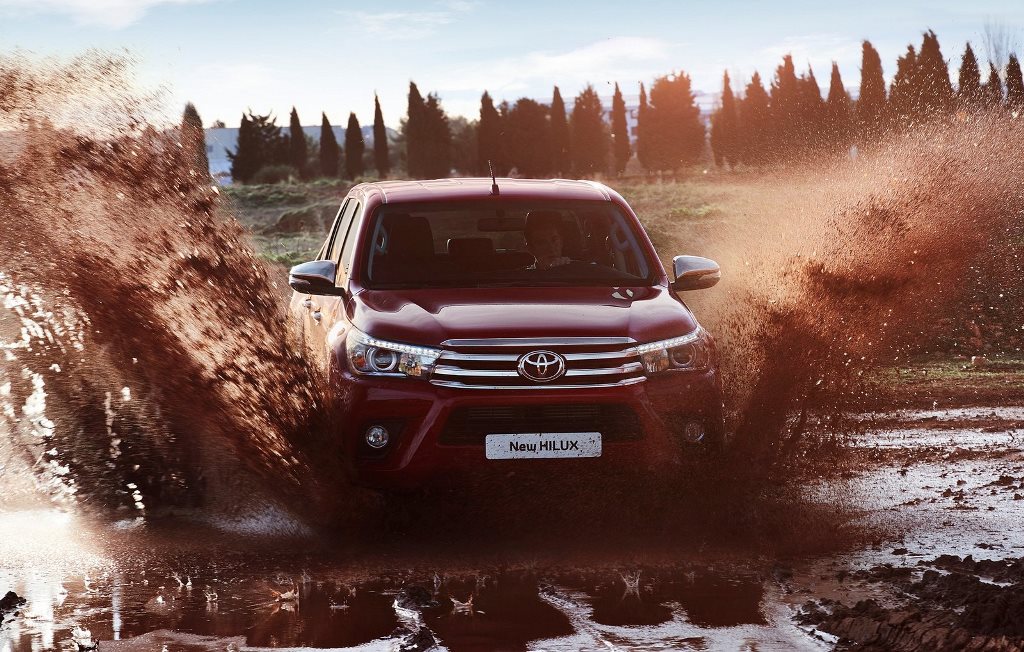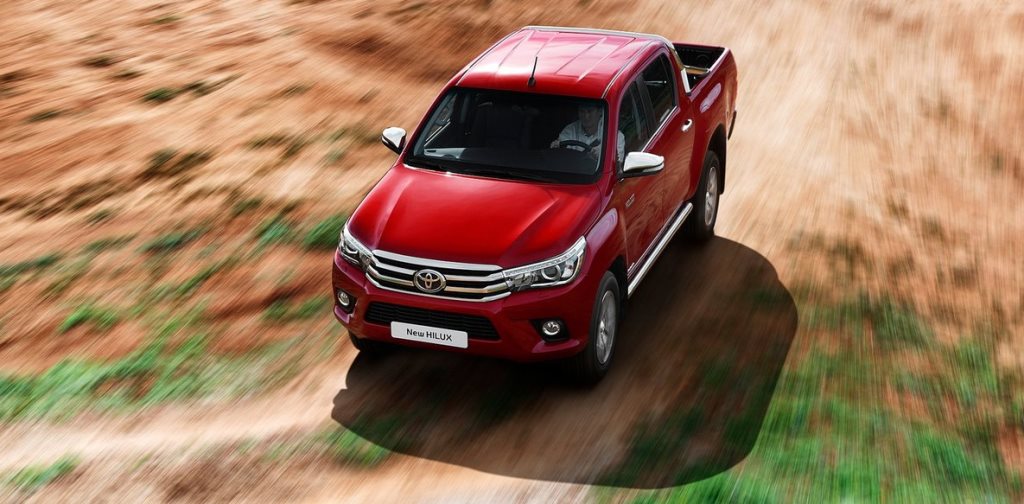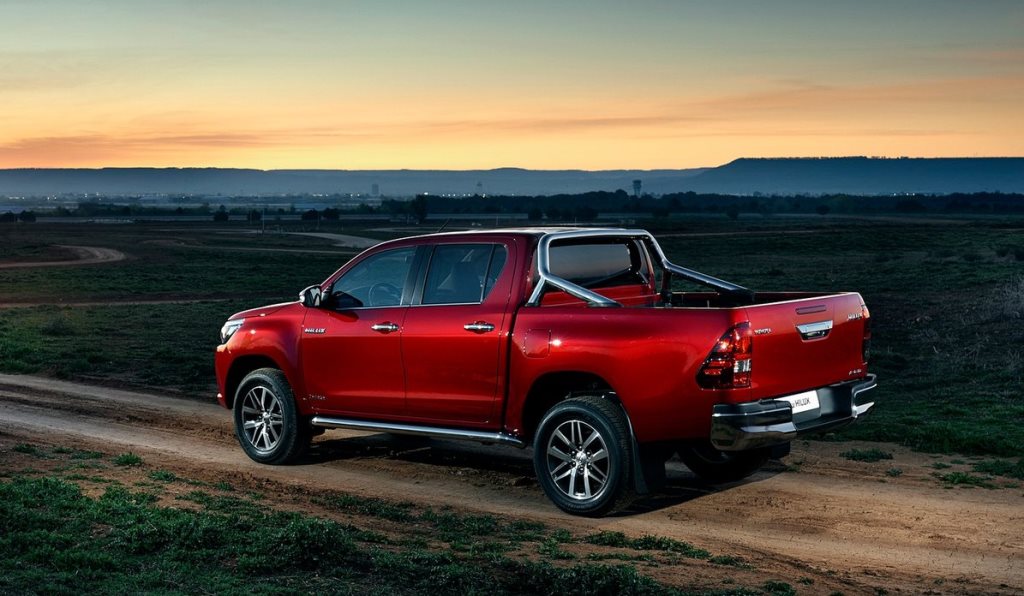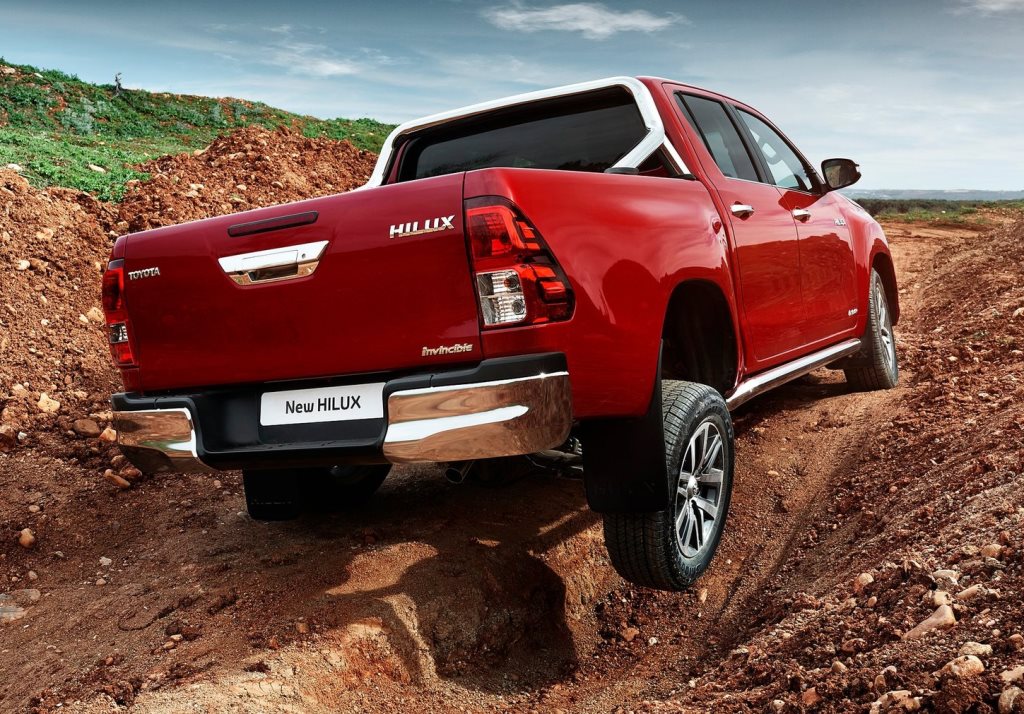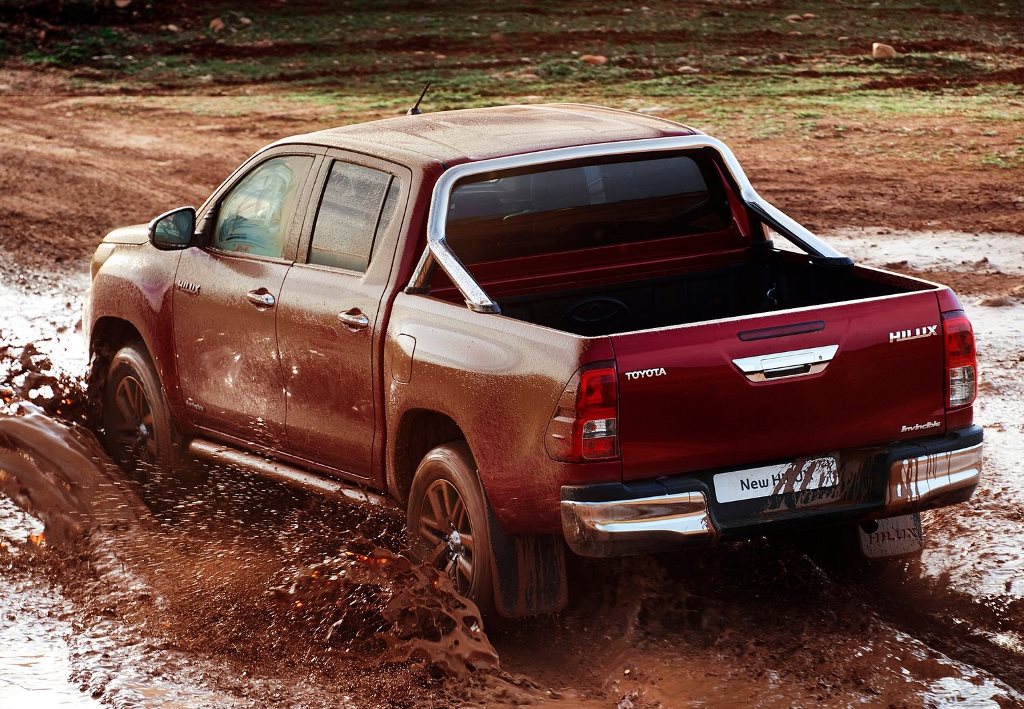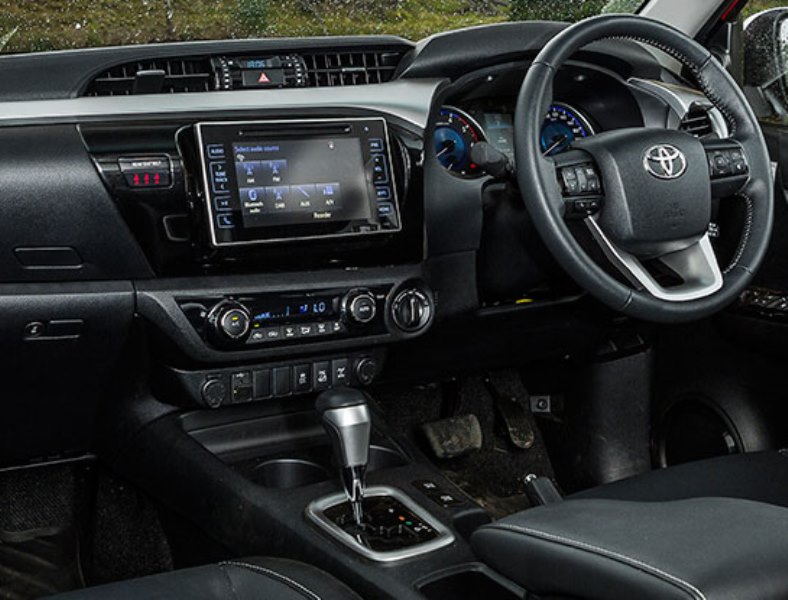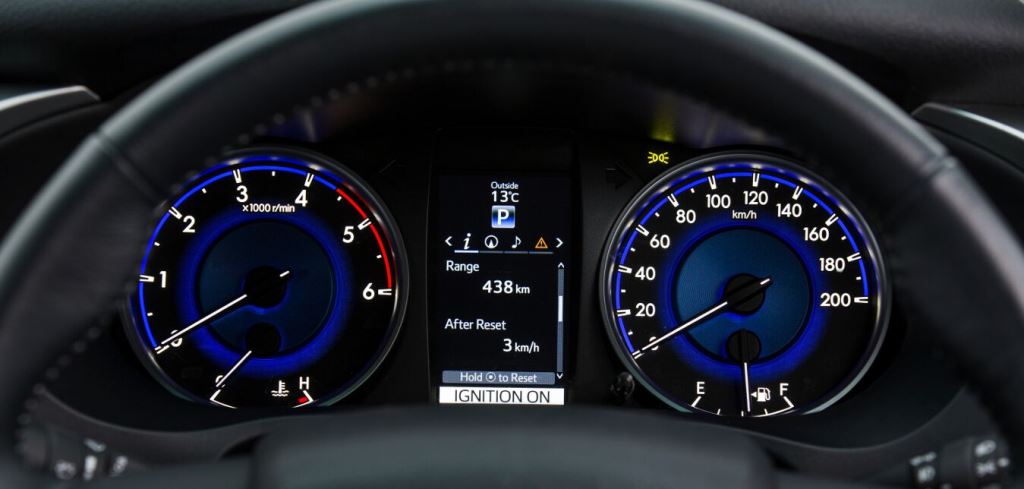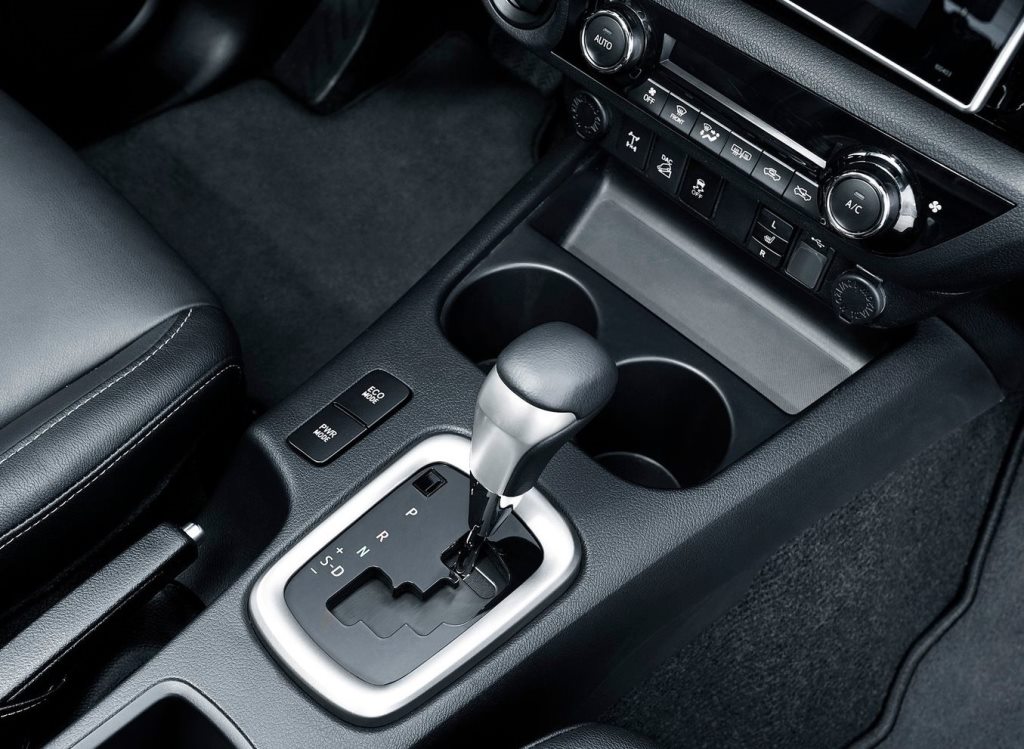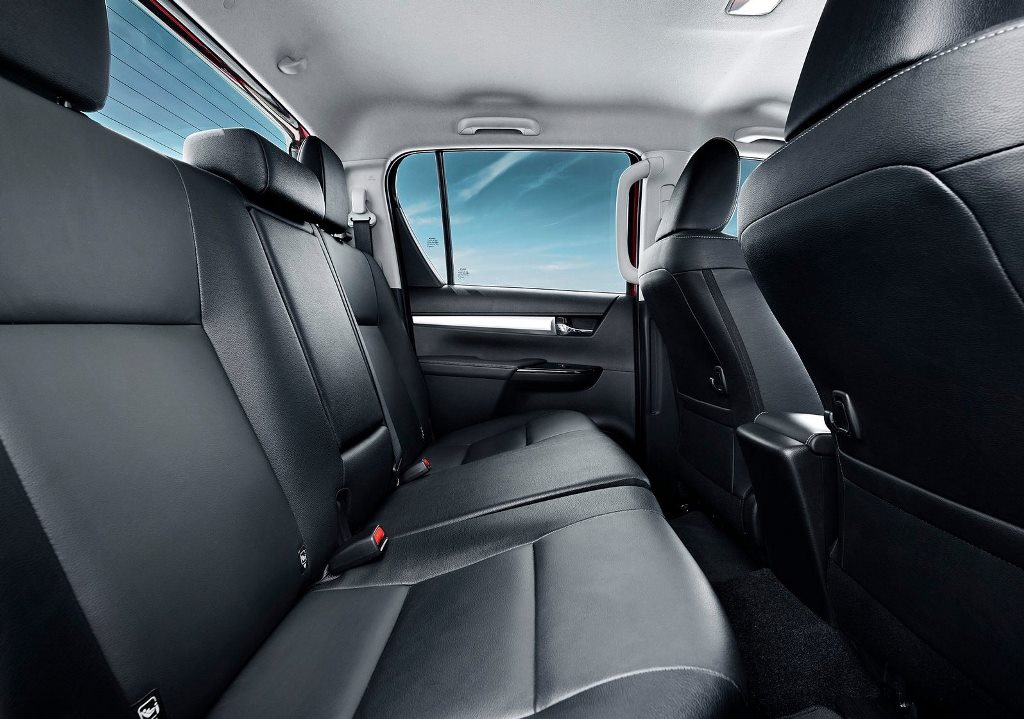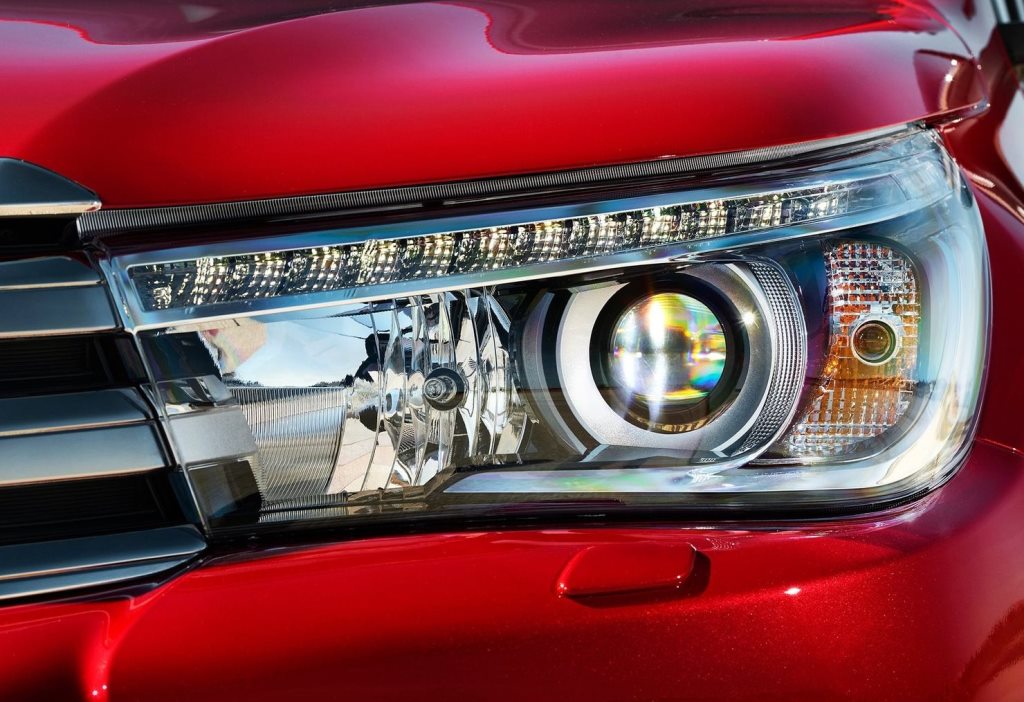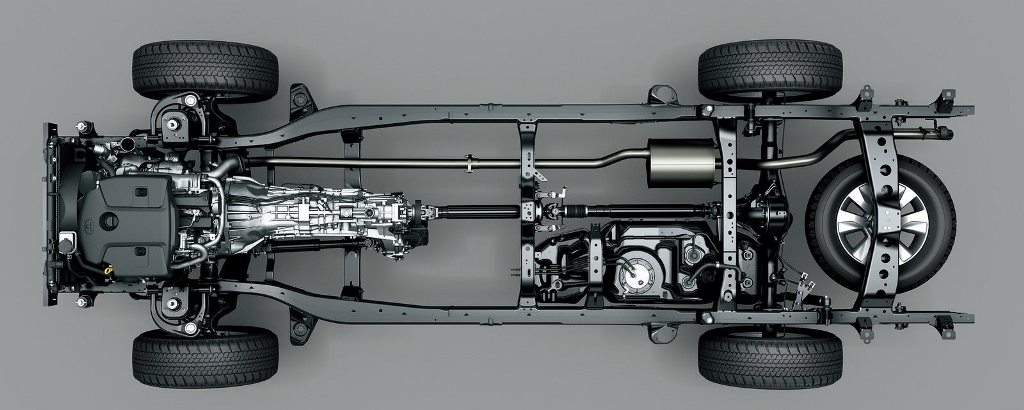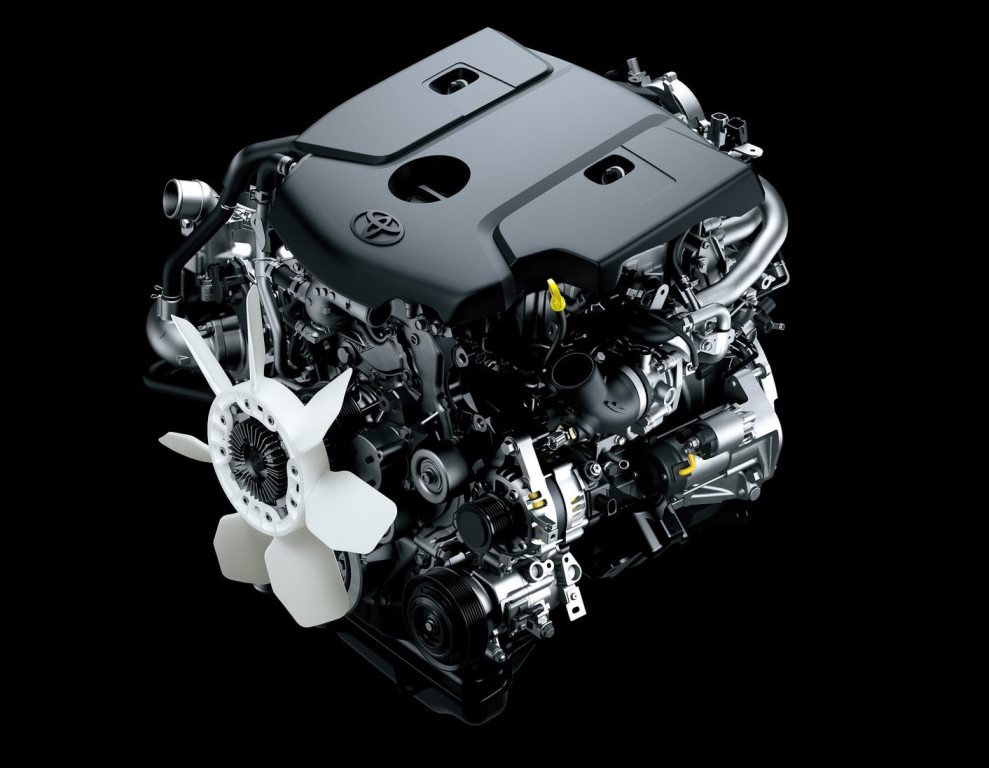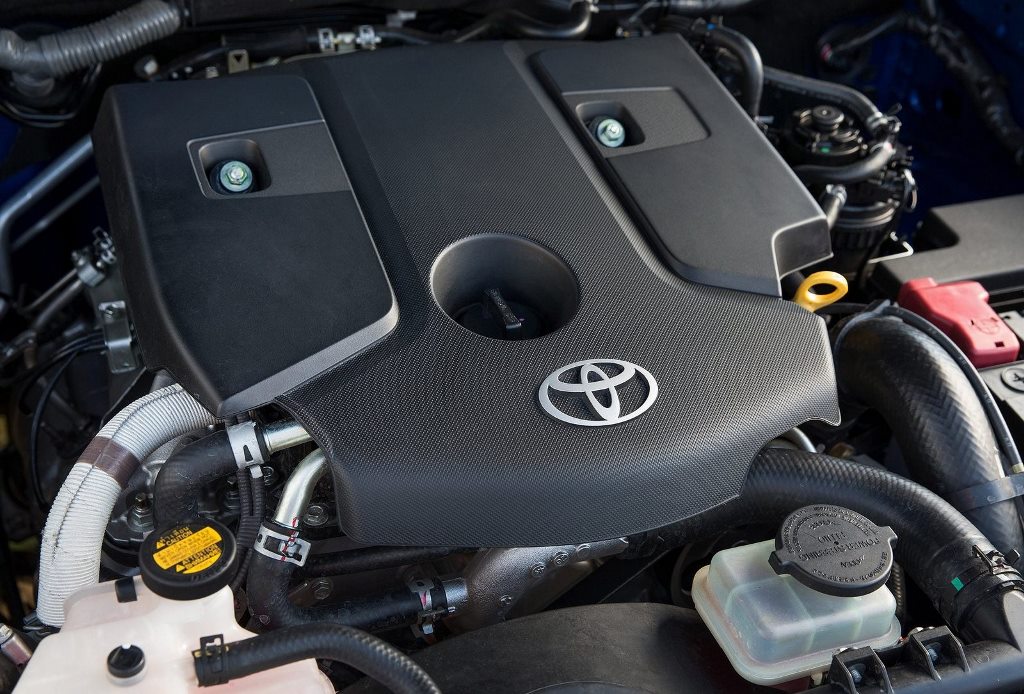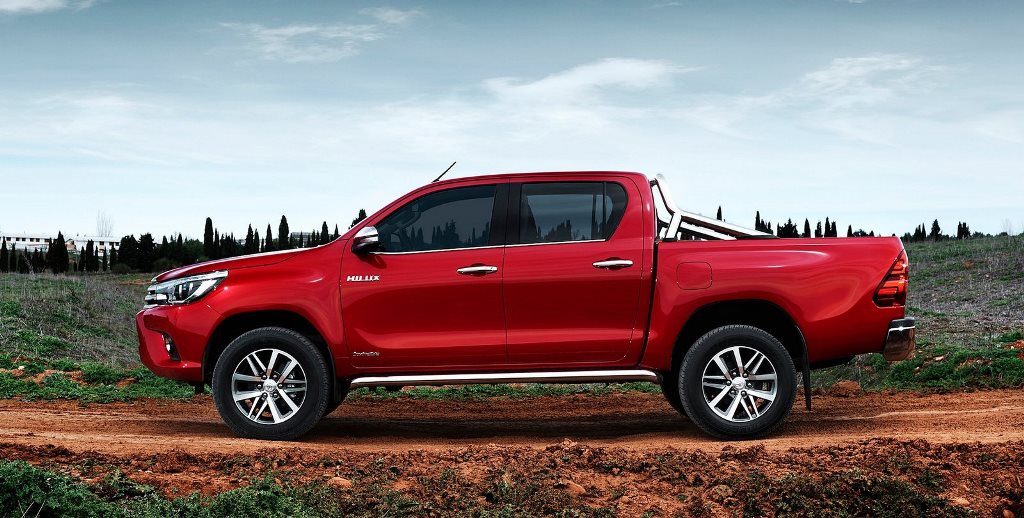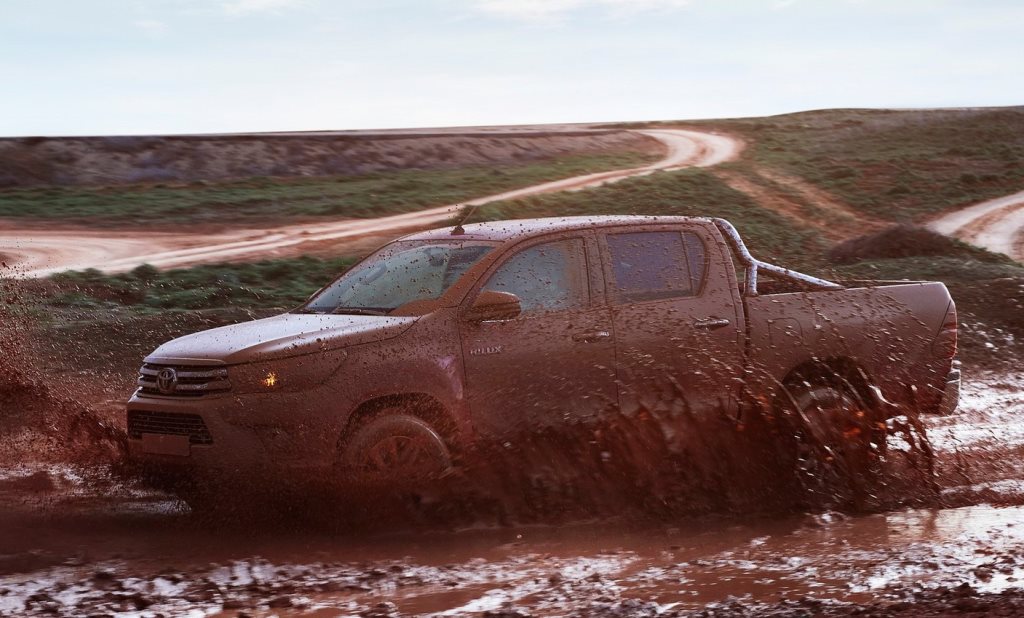Tougher, stronger and more capable off-road than ever before, the all-new Toyota remains every inch a Hilux. Yet it also heralds a new era for the pick-up, with the style, comfort, safety and advanced technology to satisfy even the most discerning leisure users.
STYLING
At 5,350 mm long, 1,855 mm wide and 1,855 mm high, the new Hilux is 90 mm longer, 20 mm wider and 5 mm lower than its predecessor.
The workhorse toughness and rugged durability inherent in every Hilux generation is now combined with the new-found levels of sophistication demanded by a growing leisure market to create the unique, next generation pick-up appeal of the all-new Hilux model range.
Nowhere is this unique combination of toughness and refinement more clearly expressed than in the new front. This combines the sleek, ‘Keen Look’ styling of a unified upper grille and headlamp design with the ruggedness of a deep, powerful bumper housing the large, ‘Under Priority’ lower grille.
Beneath the trademark ‘clamshell’ hood which wraps over the front wheel arches to reinforce the new Toyota’s solid, one-piece road presence, the second horizontal bar of the upper grille runs the full width of the new Hilux, extending into the new headlamp clusters to form a unique Daytime Running Lamp (DRL) signature featuring 12 white LEDs.
With the ‘Hilux’ signature integrated within the side of the casing, the new headlamp clusters wrap around the vehicle side fenders to further emphasise the width of the new pick-up. The advanced technology of the ‘Keen Look’ headlamp design also incorporates powerful LED low-beam projectors, available on High grade models.
Below, the bumper design emphasises the tough, durable functionality expected of any Hilux. The trapezoidal shape of the lower grille highlights Toyota’s ‘Under Priority’ design language, whilst the placement of the foglamp housings at the bumper extremities reinforces the new pick-up’s solid, stable front stance.
Flowing smoothly into a new, stronger and wider undercover, the lower corners and bottom of the bumper have been shaped to optimise ground clearance under even the most extreme off-road driving conditions.
To the sides, the new Hilux abandons a visually separate ‘over fender’ design in favour of the seamless transition of the front bumper into the muscular front wheel arches for a more refined appearance.
Both dynamism and toughness are incorporated in the profile of the new Toyota pick-up by the use of a thick lower door cross-section which links front and rear wheel arches -the latter also now seamlessly integrated within the body- before curving upwards to anchor the wrap-around rear lamp clusters.
Greater style is added to the design through the adoption of a blacked-out B pillar within the smooth, rear-slanted silhouette of the cabin and the linking of the cab and rear deck with a chrome beltline, which further unifies the overall design.
The cab roof has been carefully shaped to improve both its styling and practicality. It now features an aerodynamic, ‘pagoda’-style ‘V’ shape which helps channel air over the roof and off the sides of the vehicle, rather than into the deck where it can create drag against the tailgate. Even the minor detail of the antenna has been considered; it has been repositioned further forward to keep it clear of bulky loads or when using deck attachments.
Flanked by a new lamp cluster design which incorporates aero stabilising fins to improve aerodynamic efficiency, the rear of the 2015 Hilux features a new steel bumper which is set lower to the ground, allowing for a deeper step area to improve deck accessibility when the tailgate is closed. The rear view camera is now integrated into the handle assembly for cleaner looks and better visibility.
Interior Design – Durable and Sophisticated, with Innovative Technology
Accessed via a Smart Entry and Start system with a stylish electric key, the all-new Hilux interior combines the durability and functionality required of any working vehicle with SUV levels of refinement, sophistication and equipment.
The horizontal emphasis of the clean, uncluttered dashboard design combines premium quality elegance with the strength of a work space. The dashboard incorporates new, cross fin-type air vents with rotary dial adjustment.
The centre console is dominated by the robust tablet-like integration of a 7″ touch-screen multimedia system. Operated simply and intuitively by premium quality capacitive switchgear and fingertip flick control, the unit has been moved closer to the front seats for ease of use.
A new driver’s instrument binnacle locates large, clear, analogue speedometer and tachometer dials either side of a full colour 4.2″ TFT multi-information display. Its content changed quickly and easily via a steering wheel-mounted switch, the display places the most pertinent driving information at the highest position on the screen to minimise the shift in line-of-sight whilst driving.
Featuring a bold, horizontal spoke design to harmonise with the dashboard styling, a new steering wheel incorporates reach and rake adjustability, thumb rests and a thicker, stitched rim to guarantee a comfortable grip for all drivers.
Integral switchgear -including a four-way rocker switch- allows for quick, easy control of the 6-speaker audio and multi-information display systems, as well as linked operation of the 7″ centre console and multi-information displays.
With dial-operated temperature and airflow control and a clear LCD display, a new air-conditioning system offers occupants notably improved heating and cooling functionality. The use of an optimised compressor allows the system to generate cooler air when the engine is running at idle.
In keeping with the more leisure-oriented interior design of the new Hilux, the gear lever has been shortened to give a slicker, more passenger car-like shift action. And drive mode selection, including all-wheel drive, is now simply made via adjacent, easy-to-use switches.
The premium quality appearance and tactility of the new Hilux interior is reinforced by visually-unifying metallic coated ornamentation to the dashboard, door trim, driver’s instrument binnacle, steering wheel and gear lever bezel. Further visual harmony is created by the adoption of consistent blue illumination and instrument back-lighting throughout.
Double Cab – More Space, Greater Comfort and Comprehensive Storage
The all-new Hilux benefits from increased interior space and greater seat comfort, as well as the wealth of practical storage compartments essential to a vehicle equally at home in both business and leisure environments.
The driver’s seat hip point has been raised by 10 mm, and the height adjustment range increased by 15 mm. A front tilt function has also been added to the power adjustment controls and this, in conjunction with the addition of reach adjustment to the steering wheel, offers an ideal driving position to a wider range of occupants.
Offering occupants head- and shoulder room increases of 8 and 19 mm respectively, the front seats feature a new frame structure with a long, amply padded seat cushion optimised to provide excellent comfort support over long distances. Seat back side bolster size has also been increased to improve lateral holding performance.
The rear seats also benefit from the optimisation of the frame structure and seat cushioning, resulting in an increase in both body and leg support. This increased comfort is further enhanced by a reduction in thickness of the front seat back, creating more foot space and 10 mm greater knee room for rear seat occupants.
A 60:40 split tip-up rear seat is available to enhance Double Cab flexibility. Its lightweight structure means less effort is required to fold the seats, whilst its centre armrest is wide enough to be used by both occupants simultaneously.
The new Hilux boasts class-leading levels of practical storage. The split-level glove box features a lockable lower compartment, whilst the upper compartment is connected to the HVAC system and may be used as a cool box for the storage of two 500 ml bottles.
Beneath its padded arm rest lid, the centre console box offers storage for up to 22 CDs and an optional, AC 220V power outlet. Fold-down overhead storage is convenient for items such as sunglasses, and driver and passenger dashboard-mounted cup holders are positioned in front of the side air vents for drinks cooling.
The transmission tunnel incorporates a further large cup holder and a storage tray, adjacent to which are two DC 12V accessory sockets and both AUX and USB ports for the connection of smartphones and portable media devices.
Both front and rear door pockets will stow 1 litre plastic bottles, and the Double Cab’s rear accommodation further benefits from twin rear armrest cup holders, pockets and convenience hooks to the front seat-backs, ceiling hooks above the seats, and under-seat storage compartments.
Cabin NVH – Lowered to Passenger Car Levels
Allowing occupants to fully benefit from the new, more comfortable and sophisticated Hilux interior, the intrusion of engine, road and wind noise into the cabin has been reduced to class-leading levels.
Comprehensive sound absorption and insulation measures have been adopted throughout the new Hilux. Expansion foam is injected throughout the bodyshell structure and foam used to all seal points to prevent the transmission of noise.
A fender separator and upper and lower protectors seal the junctions of the cowl louver and front pillar with the front wing, helping to soundproof the engine bay and limit the transmission of sound from both the engine and air intake. Spot welding between the cover on top of the cowl panel and the flange creates a cowl Noise and Vibration seal and further soundproofs the engine bay.
Petrol Hilux variants now benefit from the adoption of a dash outer silencer, greatly reducing engine idling noise, whilst the existing dash outer silencer of diesel models has been made 1.5 times larger, reducing idling noise by some 3%.
In conjunction with the engine bay soundproofing, the diesel engines in the Hilux range have themselves undergone Noise- and Vibration-suppressing measures.
Diesel engine combustion noise has been reduced by optimising the shapes of the intake and Exhaust Gas Recirculation (EGR) ports, and the intake manifold, suppressing intake variations in each cylinder.
The front drive has been changed from a gear to a chain mechanism, reducing mechanical noises caused by speed fluctuations whilst idling. The form of the intake manifold has been optimised to reduce engine noise. The exhaust manifold optimises the retention capacity of the catalytic converter, lowering the noise characteristics of turbo engines. And, enhancing the vibration management of the turbocharger itself, turbocharger support rigidity has been improved.
In addition, the Hilux diesel engines benefit from the adoption of an oil pan insulation cover and a resin engine cover, both of which contribute to further reductions in engine noise.
Finally, to address wind and road noise, lips have been added to the side glass lining to decrease noise penetration, seals have been added between the front and rear doors, the range of weather strip application has been extended to the rocker area to increase noise barrier performance, and the size of the door drainage plug holes has been enlarged to further reduce noise penetration.
Cargo Deck – Larger, Stronger and More Practical
The cargo deck of the new Hilux has been made larger, stronger and more practical. Maximum cargo deck width has increased from 1,544 to a class-leading 1,645 mm. The tailgate now benefits from stronger, link-type hinges, and heavy-duty steel plate brackets have been adopted for the struts supporting it in the open position.
The deck itself has been made stronger to reduce deformation and damage when loading or unloading cargo. The floor ribs have been redesigned and sill cross-members added to the floor panel. The header panel has been reinforced, and the shape of both the wheel house rib reinforcement and the service hole cover on the tailgate optimised.
NEW ENGINE LINE-UP FOR BEST-IN-CLASS TOTAL COST OF OWNERSHIP
The all-new Toyota Hilux is available with a choice of two engines: all-new 2.4 D-4D and 2.8 D-4D Global Diesel (GD) engines. With fuel efficiency improved by some 9% over the larger capacity engines they replace, they return class-leading fuel economy figures as low as 7.3 l/100 km for the all-wheel drive 2.4 D-4D.
In combination with reduced service times, the superior fuel efficiency and reduced running costs of the new GD engines offer customers Best-in-Class Total Cost of Ownership.
The new 2.8 D-4D is equipped with all-wheel drive and a new 6-speed Super ECT automatic transmission. The Hilux drivetrain has also been upgraded to support high engine torque output. And all engines in the 2015 Hilux range are now equipped with a Drive Mode switch, allowing drivers to choose between ECO and POWER settings.
All-new 2.4 D-4D and 2.8 D-4D Global Diesel Engine
Although approximately 100 and 200 cc lower in capacity respectively than their predecessors, Toyota’s newly developed 2.4 D-4D and 2.8 D-4D GD engines combine vastly improved torque delivery in the low and medium speed ranges with class-leading fuel economy.
Both new, 16 valve, DOHC four-cylinder engines are equipped with a variable nozzle turbocharger with intercooler. The 2,393 cc 2.4 D-4D unit generates 110 kW at 3,400 rpm, and maximum torque of 400 Nm between 1,600 and 2,000 rpm. And the 2,755 cc 2.8 D-4D unit develops 130 kW at 3,400 rpm, and maximum torque of 450 Nm between 1,600 and 2,400 rpm. Both the 2.4 D-4D or 2.8 D-4D engines achieve a top speed of 170 km/h.
The fuel efficiency of both engines has improved by 9% over the units they replace. The 2.4 D-4D returns an average fuel consumption of 7.3 l/100 km when mated to a 6-speed manual gearbox, and 8.3 l/100 km with a 6-speed automatic. Mated to a 6-speed automatic gearbox, the 2.8 D-4D returns 8.5 l/100 km.
The new engines incorporate a comprehensive range of measures designed to save weight, enhance combustion efficiency and reduce friction.
A resin head cover has been adopted, and the thickness of the entire cylinder head has been reduced. The resultant weight reduction contributes significantly to lowering energy consumption and, hence, improving fuel efficiency.
The efficiency of the intake and exhaust ports, and the fuel injection system, has been optimised to maximise torque. Two intake ports are used in unison, according to the engine speed: a tangential port that produces a high swirl flow, agitating the air/fuel mixture to enhance combustion efficiency, and a helical port that achieves a high flow volume.
Both engines feature an electronically controlled, common-rail type fuel injection system that achieves higher pressure and more advanced injection pressure control, and a new piston shape has been adopted to match the new shape of the combustion chamber.
Precise pilot injection matching the state of the ambient air occurs before the main injection to shorten ignition delay, combining stable combustion in even the world’s harshest environments with quiet operation and high thermal efficiency.
The new turbocharger is 30% smaller than its predecessor and features a newly-developed turbine for improved efficiency, and a newly-developed impeller that provides instantaneous acceleration response and produces maximum torque over a wide rev range.
Both engines are equipped with a water-cooled Exhaust Gas Recirculation (EGR) system with an EGR cooler bypass function, and the 2.8 D-4D unit also benefits from a swirl control valve in the intake manifold.
The adjacent positioning of the catalyst combines cleaner performance with a reduction in size of some 30% and a reduction in the number of exhaust system components from 18 to just three. The elimination of up to 99% of NOx (nitrogen oxide) emissions through use of Toyota’s urea Selective Catalytic Reduction (SCR) system ensures the 2.4 D-4D and 2.8 D-4D Hilux complies with Euro 6 regulations.
Mechanical friction within the engines has been minimised through the adoption of a high-efficiency vacuum pump, a roller rocker-type valve train and a low friction timing chain, further improving combustion efficiency.
Enhanced 6-speed Super intelligent Electronically Controlled Automatic Transmission
The Hilux 6-speed automatic Super intelligent Electronically Controlled Transmission (6 Super ECT) benefits from several new control systems designed to improve both fuel economy and driving performance.
Making its first appearance in a Toyota vehicle, High-speed Gear Effective Utilisation Control determines the availability of high-speed gears in real time according to driving conditions. For instance, taking into account vehicle loading and throttle setting, the system will determine whether 6th gear is available or the vehicle should remain in 5th to achieve the optimum balance of driving power and fuel efficiency.
Deceleration Downshift Control optimises downshifts when decelerating to improve fuel efficiency. The fuel supply is automatically cut off during periods of engine braking, unless engine speed drops to the low rpm threshold, when fuel injection is resumed to prevent engine stalling. Accordingly, the transmission maximises engine braking by selecting a lower gear to prevent engine speed dropping below the low rpm threshold, thus extending fuel cut-off periods to drastically enhance fuel economy.
Artificial Intelligence (AI)-SHIFT Control incorporates Accelerator Immediate Close and Immediate Open Control. The former makes it easier to maintain the current gear when the accelerator pedal is suddenly released, enhancing both engine braking force and responsiveness when accelerating again. The latter performs downshifts immediately on sudden depression of the accelerator pedal, enhancing throttle response.
Upgraded, High Torque Drivetrain
The Hilux drivetrain has been upgraded to support high engine torque output. The diameter of the output shaft within the transfer case has been increased, and new differentials adopted to cope with higher torque loads. The propeller shaft has been optimised for increased torque and a higher vehicle top speed, and a torsional damper added to minimise Noise and Vibration (NV).
New Drive Mode Switch
All engines in the 2015 Hilux range are now equipped with a Drive Mode switch, allowing drivers to choose between ECO and POWER settings. ECO mode reduces power consumption in relation to acceleration, heating and cooling to improve fuel economy, whilst POWER mode offers driver’s a sharper response to throttle inputs for a more engaging driving experience.
DRIVING DYNAMICS AND OFF-ROAD ABILITY
The all-new Hilux features a newly developed ladder-frame chassis offering a 20% increase in torsional rigidity. It is designed to combine improved handling, ride comfort, NV performance and collision safety with outstanding durability in even the most extreme driving environments.
The thickness of the frame side rails and cross-members has been increased by some 30 mm, and the cross-member cross-section optimised. In conjunction with the strengthening of the frame bracket structure, this improves both cross-member deformation resistance and the fatigue strength of the suspension and front propeller shaft mountings. These measures enhance vehicle handling on rough roads and the ground-covering ability of the new Hilux.
A change in shape and an increase in thickness of the suspension installation components enhances the fatigue strength of the suspension mountings and towing hitch, awarding the new Hilux an increase in axle capacity, and raising its towing capacity to 3.2 tons.
The optimisation of the side rail cross-sections and the enhanced connection rigidity between them and the cross-members improves frame rigidity against twisting or bending. This improves vehicle yaw response and ride comfort, as well as reducing floor vibrations and engine sounds transmitted to the cabin.
Ladder-frame chassis deformation in the event of a crash is also reduced to deliver best-in-class occupant protection.
Boasting three times the deformation strength of its predecessor, a stronger, wider under cover improves protection to essential parts beneath the new all-wheel drive Hilux.
The cover area has been enlarged, reinforcement added and panel thickness increased, reducing the risk of damage to the power steering boot and camber bolt. The engine may now be fully serviced without the need to remove the under-cover, lowering service costs and, hence, the Total Cost of Ownership.
With the rigidity of its connection points to the chassis increased, the new bodyshell features a high content of 590 MPa high-tensile steel, combining light weight with optimum body strength.
It further benefits from a total of 388 spot welding points -120 more than on the current Hilux. The resultant increase in body rigidity limits deformation, improving steering accuracy and responsiveness for a more engaging driving experience.
Finally, the new Hilux features superior anti-corrosion performance to ensure a long-lasting chassis and bodyshell even when operating in the very harshest of working environments. The width of the side rails and cross-members in the chassis frame has been increased by some 30 mm to achieve a 20-years corrosion resistance.
Galvanised (GA) steel with anti-corrosive properties is used on all parts of the vehicle exterior underbody, and widely used throughout the upper body cabin and deck. The area of vehicle undercoating has been substantially increased, reducing water and dirt penetration between panel gaps, and anti-corrosive wax and chip-resistant coating optimally applied to the upper body in areas more prone to corrosion.
Pitch & Bounce Control
The all-new Hilux is equipped with Toyota’s Pitch & Bounce Control system. By automatically adjusting engine torque in direct response to road surface conditions, the system is able to reduce the pitching motion of the body, improving ride comfort and handling.
Pitch & Bounce Control uses wheel speed sensor information to establish when the nose of the vehicle is either lifted or lowered by road surface undulations. When the nose is lifted, this causes the heads of vehicle occupants to tilt backwards. The system momentarily reduces engine torque to compensate, reducing occupant head movement. When the vehicle nose dips, occupants’ heads are tilted forwards, and the system adds torque to compensate in a similar manner.
Though system adjustment of engine torque is measured in extremely small quantities, it has a noticeable effect on ride and handling. Ride comfort is improved through the perception of a flatter ride due to reduced body movement. And steering feel around the centre line is improved through better ground holding of the tyres.
Revised Suspension, Improved Power Steering and New All-terrain Tyres
The all-new Hilux’s tough, durable leaf spring and twin shock absorber rear suspension system has been extensively revised to combine the off-road articulation capabilities expected of a rugged all-wheel drive workhorse with SUV-like ride comfort and handling stability.
The length of the leaf spring has been increased by 100 mm to 1,400 mm, suppressing road surface vibration, and the attachment point of the rear suspension moved to the front of the spring. Moving the attachment point 100 mm forwards and lowering it by 25 mm contributes to enhanced steering stability.
The leaf springs have also been mounted 50 mm further apart on the ladder-frame chassis. In conjunction with an increase in the thickness of the front stabiliser bar, this contributes to increased stability when cornering and when the vehicle is loaded.
Shock absorber mounting has been adjusted, with the rear shock absorber moved forward to equalise damping force between the two, further enhancing straight-line stability.
The size of the shock absorber cylinders has been increased, making it possible to generate damping force with a small stroke to better combat small vibrations. And the damping characteristics of the shock absorbers have been optimised to give a flat ride at low speeds and reduce the impact of shocks during medium- and high-speed driving.
These rear suspension modifications have also facilitated a substantial increase in rear axle articulation, with wheel travel increasing by up to 20%, ensuring even greater levels of off-road capability over rocky or sharply undulating terrain.
The steering column has been redesigned to reduce the transfer of vibration from the road surface, and the power steering system itself has been fine-tuned. The rack ratio has been revised and the assistance characteristics of the power steering gears have been optimised to improve steering feel. Less effort is now required at low speeds, enhancing the vehicle’s tight turn performance, whilst additional steering weight adds stability at higher speeds.
Newly-developed 17″ all-terrain tyres compliment these suspension and steering enhancements with improved on-road ride comfort and superior off-road grip performance. Hilux models fitted with 18″ wheels are equipped with new, highway terrain tyres designed to minimise noise for comfortable on-road driving.
Switchable All-wheel Drive, High- and Low-ratio Drivetrain
Awarding it outstanding all-terrain capabilities, the all-new Hilux is equipped with a switchable all-wheel drive system featuring a high- and low-ratio transfer case, and both front and locking limited slip rear differentials.
A new, high-capacity rear Limited Slip Differential caters for an increase in powertrain torque. The unit has been made lighter by a reduction in the number of pinion gears from 4 to 2, and by the miniaturisation of the side bearing.
Reliability has been improved by the heat treatment of the front bearing, by the Kanigen plating of the pinion shaft and by oil seal modifications. Fuel economy has been enhanced through the adoption of highly efficient tapered roller bearings, and the use of low-viscosity differential oil.
Improving both effectiveness and reliability, the electromagnetic differential lock now features a built-in solenoid actuator.
Via a new, dashboard-mounted drive mode selection switch, the Hilux’s Automatic Disconnecting Differential system disengages the front differential when two-wheel drive is selected, enhancing refinement, fuel consumption and on-road driveability.
For increased convenience, it is possible to shift from four- to two-wheel drive on the move, and from two- to four-wheel drive at speeds below 50 km/h.
The front differential is now fitted with an oil temperature sensor to reduce the risk of overheating in all-wheel drive mode. If the oil temperature becomes abnormally high, the system alerts the drive to switch into two-wheel drive mode. If two-wheel drive is not engaged within 30 seconds, vehicle speed is automatically restricted to below 120 km/h.
New Brake Control Systems for Enhanced Off-road Capabilities
Complementing its proven, high- and low-ratio all-wheel drive powertrain, a new range of brake control systems raises the new Hilux’s off-road capabilities to Land Cruiser levels.
An Active Traction Control system (A-TRC) uses both brake fluid pressure and engine control to distribute torque appropriately to all four wheels, delivering traction superior to that offered by a limited slip differential.
On detecting a loss of traction in one or more driven wheels, the system automatically brakes the relevant wheels and simultaneously re-distributes drive torque to those which have grip. This significantly improves the Hilux’s off-road capabilities over both slippery and rocky terrain.
Downhill Assist Control (DAC) helps the driver to regulate vehicle speed on steep, slippery or bumpy downhill gradients. In circumstances when engine braking alone is insufficient to reduce vehicle speed, the system automatically controls brake fluid pressure to maintain a constant, low descent speed with the brake and accelerator pedals untouched by the driver.
Operating at speeds of less than 25 km/h, with forward speed controlled to between 5 and 7 km/h and reverse speed to between 3 and 5 km/h, DAC allows the driver to descend even the steepest slopes in stability, without the wheels locking, whilst concentrating on steering the new Hilux.
Hill-start Assist Control (HAC) prevents the vehicle from moving backwards during an uphill start when the driver releases the brake pedal. The system temporarily maintains braking to all four wheels for a maximum of two seconds in order to hold the vehicle in place and prevent rollback.
SAFETY
The Hilux’s new, stronger, ladder-frame chassis offers increased deformation resistance, whilst its energy absorption performance has increased by 15% over that of its predecessor. This improves safety performance and occupant protection.
The chassis absorbs collision forces in three stages to reduce the effects of impacts on the body, engine and interior. Firstly, the front side rail extension area crumples and buckles. Secondly, the side rail collapses vertically near the suspension tower. And, thirdly, the side rail bends inwards in the ‘kick’ range.
Any residual front or side impact energy unabsorbed by the deformation of the frame structure is effectively distributed through the upper, lower and underside bodyshell structural members. The bodyshell itself features a high content of 590 MPa high-tensile steel, combining light weight with optimum strength to help reduce occupant injuries.
The risk of pedestrian injury has also been reduced by the adoption of impact absorbing structures to the front bumper, bonnet, fender bracket structure and cowl structure, reducing impact force to the head and legs of pedestrians during a collision.
The new Hilux 2.8G (AT) 4×4 Double Cab is equipped with 7 (seven) Supplemental Restraint System (SRS) airbags: driver and passenger front and side airbags, a driver knee airbag and curtain shield airbags covering both front and rear seats. While the other versions get 3 (three) airbags.
All front and rear seats are fitted with three-point, Emergency Locking Retractor (ELR) seat belts. The front belts further benefit from a pretensioner and force limiter function. A seat belt reminder is provided for all seats, and the rear seats are also equipped with a Child Restraint System (CRS) top tether anchor for the securing of ISOFIX child seats.
Comprehensive Brake Control Systems
The all-new Hilux is equipped with a comprehensive array of brake control systems to help prevent accidents, maximise vehicle stability and even help drivers control trailers during difficult driving conditions.
The Anti-lock Brake System (ABS) prevents the wheels from locking under heavy braking. Brake Assist (BA) generates a large brake force during emergency braking, supplementing the efforts of drivers who may not be able to depress the brake pedal with sufficient force.
An Emergency Brake Signal automatically flashes the vehicle’s hazard warning lights during emergency braking, warning following vehicles to help reduce the possibility of a rear-end collision.
Electronic Brakeforce Distribution (EBD) automatically distributes brake force between the front and rear wheels according to vehicle and road surface conditions. This not only optimises braking performance, but also reduces the brake pedal force required for effective braking.
Vehicle Stability Control (VSC) activates when sensors detect understeer or oversteer whilst the vehicle is turning. The system uses automatic control of both engine output and individual wheel brakes to counter the effects of understeer or oversteer, significantly enhancing vehicle stability and, hence, safety.
Full described in the Driving Dynamics chapter, the new Hilux also benefits from three further new brake control systems -an Active Traction Control system (A-TRC), Downhill Assist Control (DAC) and Hill-start Assist Control (HAC), which combine significantly enhanced active safety levels with simple, intuitive driver assistance under even the most extreme off-road conditions.

